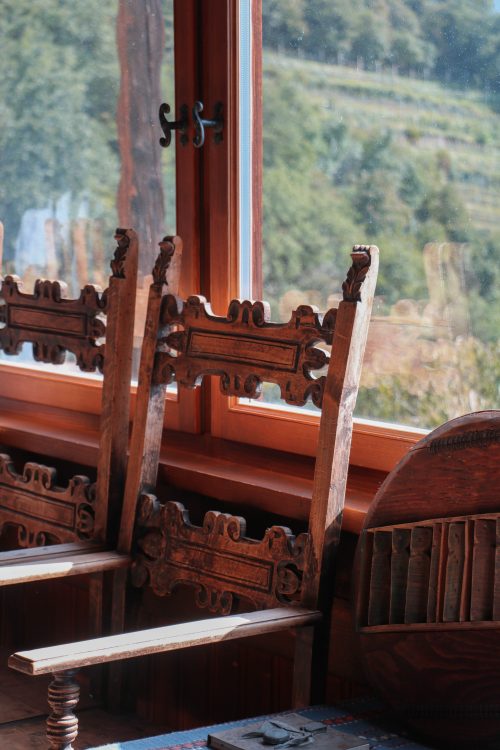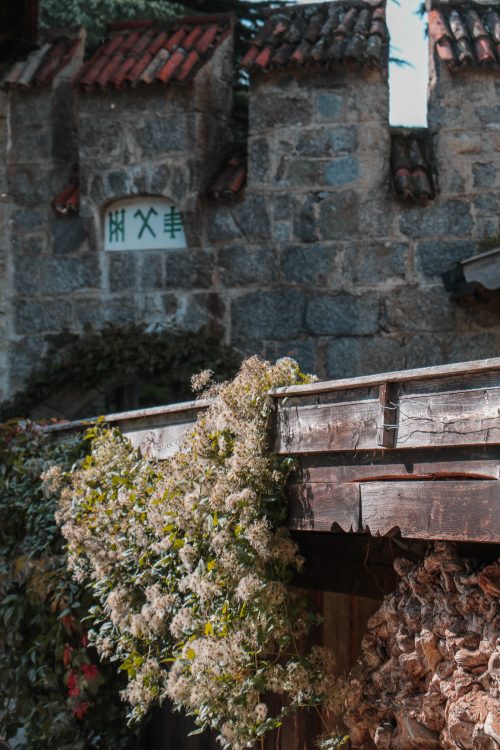Das heftige Herbstlicht schneidet die Brunnenburg bis ins kleinste Detail aus und hebt sie so deutlich vom grünen Bouquet der Kastanie ab, in die sie getaucht ist. Wenn man den Weg betritt, der zum Eingang führt, scheint man in eine märchenhafte Ruhe zu versinken. Die Geräusche des Stadtlebens verklingen und werden ersetzt durch das Rauschen der Bäche, dem Wind, der weht, um den Hang zu erfrischen. In diesem malerischen Rahmen trifft BAU im Zuge der Recherche der Futurefarmers Residency Siegfried de Rachewiltz, Direktor des Zentrums für Internationale Studien der Brunnenburg, sowie Ethnologen mit einem einzigartigen Bildungsweg zwischen Meran und Harvard, der ihn zu einem Freiwilligeneinsatz in Marokko führte. Erwähnenswert ist seine Funktion als Direktor des Schloss Tirol, dem Südtiroler Landesmuseum für Kultur- und Landesgeschichte von 1991 bis 2013. Sein ausgeprägtes akademischesInteresse erkennt man sofort, wenn man ihn erzählen hört von der Ausstellung, die derzeit innerhalb der Schlossmauern zu sehen ist und von de Rachewiltz kuratiert wurde: Es ist ein historischer Exkurs über die Tradition der Rüben und des Krauts im historischen Tirol, die zum Vorwand wird, um über Folklore, Rituale und schützenswerte kulturelle Praktiken zu sprechen.
The violent autumn light carves out Castel Fontana in minute detail, which stands out from the green chestnut bouquet in which it is immersed. Entering the path that leads to the entrance, it seems to sink into a fairy-tale quietness. The noises of city life fade away, replaced by the roar of gentle streams, the wind blowing, to refresh the slopes. In this picturesque frame, BAU meets as part of the research for the Futurefarmers Residency, Siegfried de Rachewiltz, director of the Center for International Studies at Castel Fontana, as well as ethnologist with a unique education, articulated between Merano and Harvard, which led him to work as a volunteer in Morocco. It is important to mention his role as director of Castel Tirolo, the South Tyrolean Museum of Culture and Provincial History from 1991 to 2013. His strong academic interest can be immediately perceived by listening to him illustrate the current exhibition he curated within the castle walls. It is a historical excursus on the tradition of Turnips and cabbage in the historical Tyrol, which becomes a pretext to talk about folklore, rituals, and cultural practices to be protected.
La violenta luce autunnale ritaglia con minuzia Castel Fontana, che si distacca con nitidezza dal verde bouquet di castagni in cui è immerso. Addentrandosi nel sentiero che conduce all’ingresso par di sprofondare in una quiete fiabesca. I rumori della vita cittadina si affievoliscono, sostituiti dallo scroscio di ruscelli, dal vento che spira, a rinfrescare il pendio. In questo pittoresco contesto, come parte della ricerca per la residenza artistica di Futurefarmers, BAU incontra Siegfried de Rachewiltz, direttore del Center for International Studies di Castel Fontana, nonché etnologo dal singolare percorso formativo, articolato tra Merano ed Harvard, che lo ha portato a lavorare come volontario in Marocco. Importante menzionare il suo ruolo di direttore, dal 1991 al 2013, di Castel Tirolo, il museo storico-culturale della Provincia di Bolzano. Lo spiccato interesse accademico e divulgativo si percepisce immediatamente ascoltandolo illustrare la corrente mostra da lui curata, ospitata all’interno delle mura del castello. Si tratta di un excursus storico sulla tradizione di crauti e cavoli nel Tirolo storico, che diventa pretesto per parlare di folklore, rituali e pratiche culturali da proteggere.





